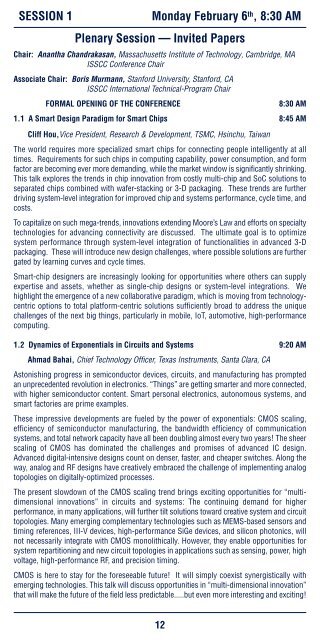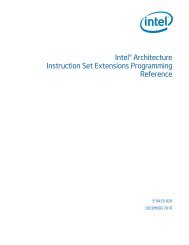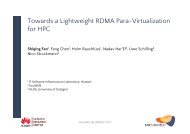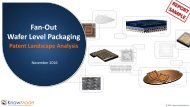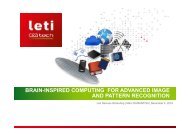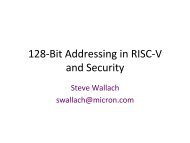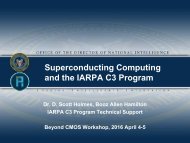PHYSIOLOGICAL-READOUT
ISSCC2017AdvanceProgram
ISSCC2017AdvanceProgram
You also want an ePaper? Increase the reach of your titles
YUMPU automatically turns print PDFs into web optimized ePapers that Google loves.
SESSION 1<br />
Monday February 6 th , 8:30 AM<br />
Plenary Session — Invited Papers<br />
Chair: Anantha Chandrakasan, Massachusetts Institute of Technology, Cambridge, MA<br />
ISSCC Conference Chair<br />
Associate Chair: Boris Murmann, Stanford University, Stanford, CA<br />
ISSCC International Technical-Program Chair<br />
FORMAL OPENING OF THE CONFERENCE<br />
8:30 AM<br />
1.1 A Smart Design Paradigm for Smart Chips 8:45 AM<br />
Cliff Hou,Vice President, Research & Development, TSMC, Hsinchu, Taiwan<br />
The world requires more specialized smart chips for connecting people intelligently at all<br />
times. Requirements for such chips in computing capability, power consumption, and form<br />
factor are becoming ever more demanding, while the market window is significantly shrinking.<br />
This talk explores the trends in chip innovation from costly multi-chip and SoC solutions to<br />
separated chips combined with wafer-stacking or 3-D packaging. These trends are further<br />
driving system-level integration for improved chip and systems performance, cycle time, and<br />
costs.<br />
To capitalize on such mega-trends, innovations extending Moore’s Law and efforts on specialty<br />
technologies for advancing connectivity are discussed. The ultimate goal is to optimize<br />
system performance through system-level integration of functionalities in advanced 3-D<br />
packaging. These will introduce new design challenges, where possible solutions are further<br />
gated by learning curves and cycle times.<br />
Smart-chip designers are increasingly looking for opportunities where others can supply<br />
expertise and assets, whether as single-chip designs or system-level integrations. We<br />
highlight the emergence of a new collaborative paradigm, which is moving from technologycentric<br />
options to total platform-centric solutions sufficiently broad to address the unique<br />
challenges of the next big things, particularly in mobile, IoT, automotive, high-performance<br />
computing.<br />
1.2 Dynamics of Exponentials in Circuits and Systems 9:20 AM<br />
Ahmad Bahai, Chief Technology Officer, Texas Instruments, Santa Clara, CA<br />
Astonishing progress in semiconductor devices, circuits, and manufacturing has prompted<br />
an unprecedented revolution in electronics. “Things” are getting smarter and more connected,<br />
with higher semiconductor content. Smart personal electronics, autonomous systems, and<br />
smart factories are prime examples.<br />
These impressive developments are fueled by the power of exponentials: CMOS scaling,<br />
efficiency of semiconductor manufacturing, the bandwidth efficiency of communication<br />
systems, and total network capacity have all been doubling almost every two years! The sheer<br />
scaling of CMOS has dominated the challenges and promises of advanced IC design.<br />
Advanced digital-intensive designs count on denser, faster, and cheaper switches. Along the<br />
way, analog and RF designs have creatively embraced the challenge of implementing analog<br />
topologies on digitally-optimized processes.<br />
The present slowdown of the CMOS scaling trend brings exciting opportunities for “multidimensional<br />
innovations” in circuits and systems: The continuing demand for higher<br />
performance, in many applications, will further tilt solutions toward creative system and circuit<br />
topologies. Many emerging complementary technologies such as MEMS-based sensors and<br />
timing references, III-V devices, high-performance SiGe devices, and silicon photonics, will<br />
not necessarily integrate with CMOS monolithically. However, they enable opportunities for<br />
system repartitioning and new circuit topologies in applications such as sensing, power, high<br />
voltage, high-performance RF, and precision timing.<br />
CMOS is here to stay for the foreseeable future! It will simply coexist synergistically with<br />
emerging technologies. This talk will discuss opportunities in “multi-dimensional innovation”<br />
that will make the future of the field less predictable.....but even more interesting and exciting!<br />
12


